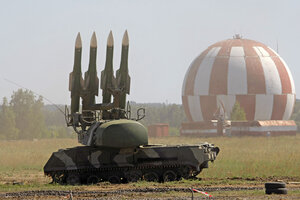The BUK: Weapon that brought down MH17?
Malaysia Airlines Flight MH17 is widely believed to have been shot down with the Soviet-era BUK anti-aircraft system – a complex, but still widely used and effective weapon.

This Wednesday, June 30, 2010, file photo shows the Buk M2 missile system at a military show at the international forum "Technologies in machine building 2010" in Zhukovsky, Russia, outside Moscow. It is believed that a BUK missile shot down Malaysia Airlines flight MH17 was flying at an altitude of 33,000 feet Thursday.
Mikhail Metzel/File/AP
Moscow
There is still no agreement over who may have destroyed Malaysia Air Flight MH17, but there is an emerging consensus about what did it: a mobile Soviet-era air defense missile system known as BUK.
The BUK is a ubiquitous feature of post-Soviet armies in its SA-11 (NATO reporting name Gadfly) or more advanced SA-17 (Grizzly) variants. Designed to accompany Soviet forces into the field and protect them from aerial attack, the tractor-mounted multiple-missile batteries, with their accompanying radar vehicles, are still the main point defense system for both the Russian and Ukrainian armed forces.
Experts say that despite its age, the BUK remains a highly effective battlefield weapon. It's able to engage several targets at once and strike at a distance of up to 18 miles. That would have put MH17, flying at an altitude of 5 miles, well within its reach. Experts say the BUK has an independent radar guidance system, which means it can operate on its own, without being plugged into any wider air defense network.
It is the kind of weapon that is usually associated with a state actor and the rebels now insist that they possess only Strela and Igla portable anti-aircraft missiles, with effective ranges of no more than 2 miles.
But Russian media reported in late June that rebels in Donetsk region overran a Ukrainian army anti-aircraft station and "took control" of at least one BUK unit. On the morning MH17 was shot down, AP journalists reported seeing what "looked like a BUK missile system near the rebel-held eastern town of Snizhne" in Donetsk region.
Russian military experts say that just because the insurgents may have had one of the systems doesn't mean they were able to use it.
"This is really complicated equipment. A person from the street can no more step in and operate it than he could suddenly become an airline pilot," says Igor Korotchenko, director of the independent Center of Analysis of the World Arms Trade in Moscow.
"Trained officers need at least 6 months of additional training to run a BUK system. It needs a whole, well prepared team to make it work."
But analysts point out that plenty of the Russian volunteers who've been coming across the border to fight alongside Ukrainian rebels have military experience, while insurgent ranks have also been filled out with defectors from Ukraine's military.
It seems probable that a rebel BUK system was responsible for taking down a Ukrainian An-26 transport aircraft, flying at around 20,000 ft, on Monday. On Thursday, when MH17 came down, the rebels at first claimed that they'd destroyed another An-26 – before deleting all references to it. But the report was picked up by Russian media, who have made no effort to scrub it.
For its part, Russia's Defense Ministry claimed Friday that Kiev forces have deployed their own BUK systems all over eastern Ukraine. It also insists that radar intercepts taken on Thursday showed that Ukrainian BUK, as well as S-200 long-range air defense systems located along MH17's flight path, showed plenty of activity.

